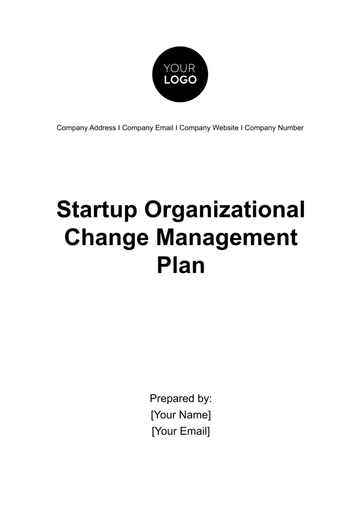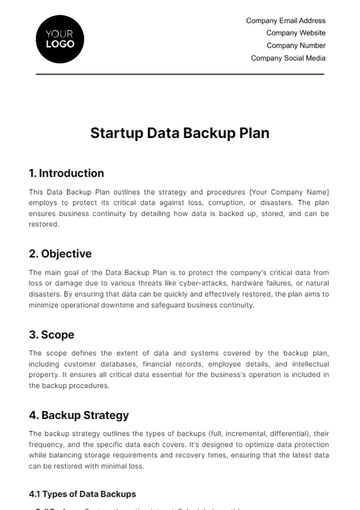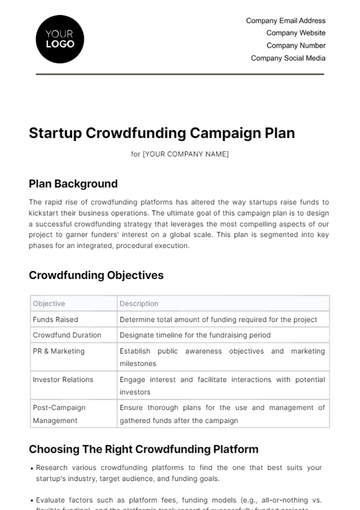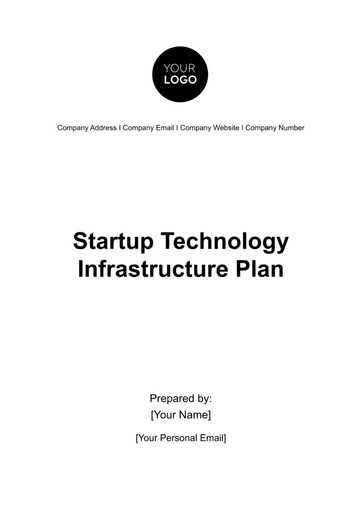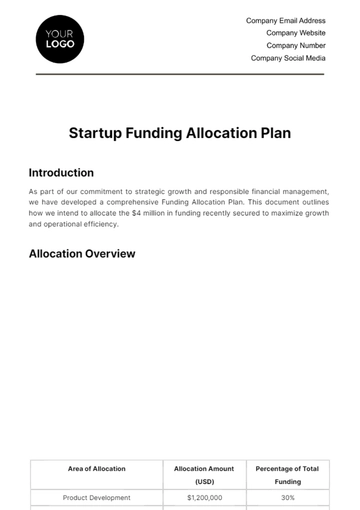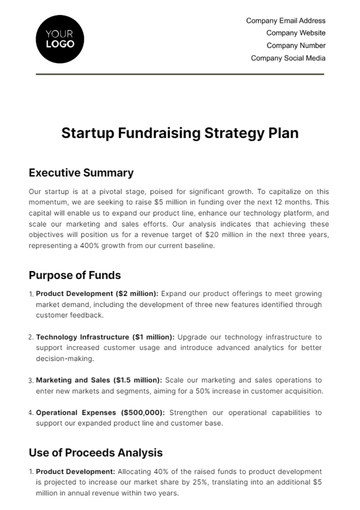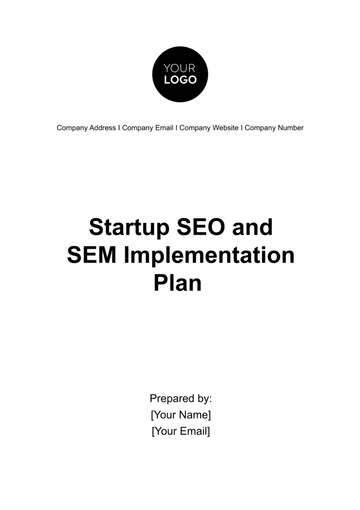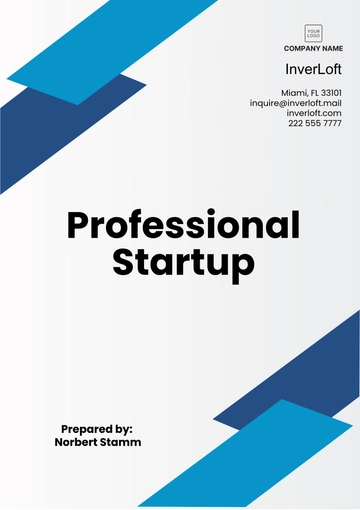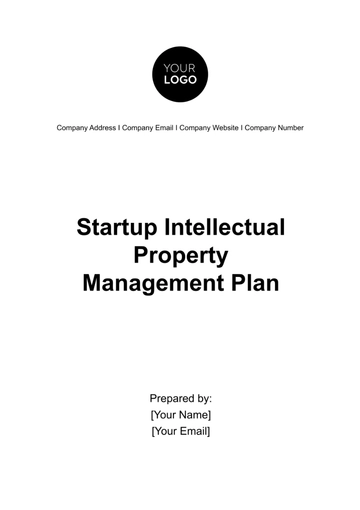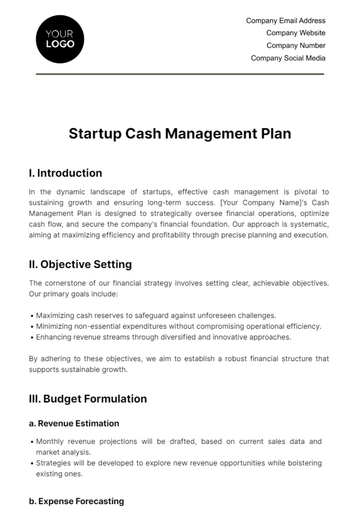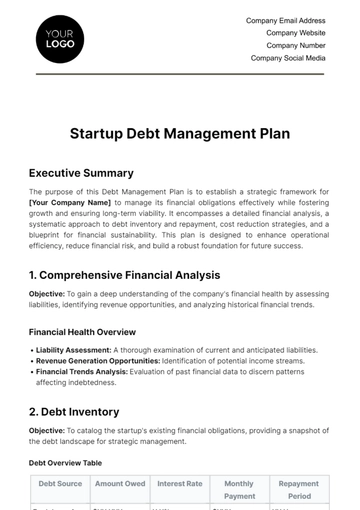Free Startup Intellectual Property Management Plan

Table of Contents
Introduction
1. Awareness and Education
2. IP Asset Identification
3. Determining Ownership
4. IP Protection
5. Technology Transfer and Licensing
6. IP Portfolio Management
7. Monitoring Competitor IP
8. IP Risk and Conflict Management
9. IP Budgeting
10. External IP Consultation
Conclusion
Introduction
In today’s innovation-driven economy, intellectual property (IP) stands as a cornerstone of competitive advantage and market differentiation for startups. An effective Intellectual Property Management Plan is not merely about safeguarding ideas; it's a strategic framework that encompasses awareness, protection, and leveraging of IP assets to fuel growth, foster innovation, and navigate the complex landscape of global markets. This plan outlines a comprehensive approach to managing [Your Company Name]'s intellectual assets, ensuring they are meticulously identified, protected, and optimized for the company’s long-term success.
1. Awareness and Education
In the rapidly evolving landscape of innovation, the cultivation of an IP-conscious culture within [Your Company Name] is not just beneficial—it's imperative. By embedding awareness and education on intellectual property (IP) at the core of our operations, we aim to empower every team member with the knowledge and tools necessary to protect and leverage our IP assets effectively. This commitment to fostering IP literacy will ensure that our innovations are not only recognized but also securely protected, providing a solid foundation for our competitive advantage and long-term success.
Embedding a culture of IP awareness across [Your Company Name] begins with comprehensive education initiatives tailored to various roles within the organization. By conducting targeted workshops and training sessions, we can illuminate the nuances of IP rights and the importance of safeguarding our intellectual assets. These educational programs, led by seasoned IP professionals, will cover the spectrum of IP types—patents, trademarks, copyrights, and trade secrets—and their applicability to our business processes. This ensures that every team member, from R&D to marketing, understands their role in identifying and protecting IP, fostering a collective responsibility towards our intellectual assets.
Moreover, [Your Company Name]’s commitment to IP education extends beyond initial training sessions. We plan to integrate IP awareness into our ongoing professional development programs, ensuring that our team remains abreast of the latest developments in IP law and practice. Regular updates, newsletters, and refresher courses will be part of our strategy to keep IP protection at the forefront of our team’s mind. This continuous learning environment will not only enhance our team's ability to innovate with confidence but also ensure that our approach to IP management evolves in line with new technologies, market trends, and legal landscapes. By prioritizing awareness and education, [Your Company Name] is laying the groundwork for a culture where innovation is not only nurtured but also comprehensively protected.
2. IP Asset Identification
Recognizing and cataloging our IP assets is critical for deploying effective protection mechanisms and unlocking their commercial potential. This section outlines our approach to building a dynamic IP inventory, a foundational tool that ensures every innovation and creative output is accurately documented, legally protected, and strategically leveraged for business growth and competitive advantage.
IP Asset Identification: Comprehensive Table Format
IP Asset Name | Type of IP | Ownership | Protection Status | Commercial Value | Action Plan |
|---|---|---|---|---|---|
[Software Name] | Patent/Trade Secret | Owned by [Your Company Name] | Patent filed - Pending approval/ Trade secret maintained internally | High potential due to unique market application | Finalize patent process/ Implement non-disclosure agreements |
3. Determining Ownership
Establishing unequivocal ownership stands as a critical pillar for [Your Company Name]. This section underscores our strategic approach to delineating IP ownership rights, a measure that not only prevents potential disputes but also fortifies our position in securing investments and partnerships. By embedding clear ownership clauses in all agreements with employees and contractors, we ensure that IP created under [Your Company Name]'s auspices is unequivocally owned by the company, paving the way for seamless commercialization and protection of our intellectual assets.
Determining ownership of intellectual property (IP) within [Your Company Name] is a foundational step that impacts everything from our ability to innovate to how we engage in the marketplace. To this end, we meticulously draft and review all employment and contractor agreements to include specific provisions that assign IP rights created during the course of employment or contract to [Your Company Name]. This legal clarity is not merely about asserting control; it's a strategic move to safeguard our innovations and ensure that every piece of intellectual property is a tangible asset that can contribute to our growth, attract investors, and facilitate strategic partnerships. By establishing clear ownership from the outset, we mitigate the risk of future disputes that could hinder our operational fluidity or dilute our asset portfolio.
Moreover, [Your Company Name]'s proactive stance on IP ownership extends to ongoing education and dialogue with our team members and partners about the importance of IP rights and the implications of these agreements. This open communication fosters an environment of transparency and trust, ensuring that all stakeholders understand the value of IP to our business's success and their role in its protection and enhancement. Additionally, this clarity in ownership simplifies the process of IP asset management, from applying for protection to engaging in licensing or sale transactions, thereby streamlining our operations and reinforcing our market position. Through rigorous attention to determining IP ownership, [Your Company Name] not only protects its innovative output but also secures a foundation for sustained competitive advantage and market leadership.
4. IP Protection
In the competitive landscape that [Your Company Name] operates within, the strategic protection of intellectual property (IP) assets is not just a legal formality but a core business strategy. This section delineates our comprehensive approach to safeguarding our innovations and creative works. By judiciously employing patents, trademarks, copyrights, and trade secrets, and collaborating with IP professionals, we ensure our IP protection measures are robust, strategically aligned, and capable of maximizing the commercial potential and longevity of our intellectual assets. This proactive stance on IP protection is fundamental to maintaining our competitive edge and fostering long-term business growth.
IP Protection: Comprehensive Table Format
To operationalize our IP protection strategy, [Your Company Name] utilizes a detailed management system. Below is a table format that exemplifies our methodical approach to securing our IP assets, ensuring each is appropriately safeguarded and its strategic value to the company is maximized.
IP Asset Name | Type of IP | Protection Strategy | Status | Next Steps | Expected Outcome |
|---|---|---|---|---|---|
[Software Name] | Patent/Trade Secret | Patent application filed for core technology; key algorithms maintained as trade secrets | Patent pending; Trade secret internal protocols established | Monitor patent application status; Continue rigorous trade secret protocols | Secure exclusive rights to technology; Maintain competitive advantage through non-disclosure |
Strategic Implementation and Next Steps
The table above illustrates [Your Company Name]'s strategic approach to IP protection, showcasing how different types of IP assets are safeguarded through tailored strategies. This detailed planning ensures that every asset, from software and brand logos to innovative processes and creative works, is optimally protected according to its nature and commercial relevance.
Our next steps involve not only vigilant monitoring of the IP landscape, including the status of pending protections and potential infringements but also actively exploring opportunities to leverage our protected assets for business growth. This might include licensing agreements that generate revenue streams or the strategic use of trademarks and patents to strengthen our market position. Furthermore, regular consultations with IP professionals will ensure that our protection strategies evolve in line with the latest legal developments and business objectives.
By meticulously managing our IP protection efforts, [Your Company Name] secures the foundation of its innovation-driven competitive advantage. This commitment to safeguarding our intellectual assets underpins our strategic goals, ensuring long-term business resilience and success in the ever-evolving marketplace.
5. Technology Transfer and Licensing
In the dynamic ecosystem of innovation, [Your Company Name] recognizes technology transfer and licensing as pivotal strategies for unlocking the full potential of our intellectual property (IP). This section outlines our structured approach to transforming IP assets into valuable commercial products and strategic alliances. Through well-defined policies, valuation frameworks, and negotiation strategies, we aim to facilitate seamless licensing transactions, thereby catalyzing revenue growth and fostering market expansion. Our proactive engagement in technology transfer and licensing not only enhances our financial portfolio but also amplifies our influence and presence in new and existing markets.
Technology Transfer and Licensing: Comprehensive Table Format
IP Asset | Licensing Strategy | Valuation Method | Negotiation Strategy | Expected Outcome |
|---|---|---|---|---|
[Software Name] | Exclusive licensing | Cost-based valuation with market comparables | Tiered pricing based on market size; Performance clauses | Penetrate international markets; Increase revenue streams |
Strategic Implementation and Next Steps
This table reflects [Your Company Name]'s tailored approach to each IP asset, highlighting the diversity of our licensing strategies to maximize commercial success. The strategic selection between exclusive and non-exclusive licensing agreements allows us to align with our broader business goals, whether that's market penetration, revenue generation, or brand enhancement. Our valuation methods are chosen to reflect the unique characteristics and market potential of each IP asset, ensuring fair and advantageous licensing terms.
In moving forward, [Your Company Name] will continue to refine our licensing frameworks and explore new opportunities for technology transfer. This includes staying abreast of market trends to identify potential partners, utilizing advanced valuation techniques for accurate pricing, and developing flexible negotiation strategies that can adapt to the varying needs of licensees. Through these concerted efforts, we aim to not only foster lucrative licensing deals but also to build enduring strategic partnerships that contribute to our long-term vision and growth.
By prioritizing technology transfer and licensing as key components of our IP strategy, [Your Company Name] positions itself at the forefront of innovation commercialization. This proactive approach not only generates significant revenue but also extends our technological and brand influence across industries and geographies, underscoring our commitment to leveraging intellectual property for strategic advantage and market leadership.
6. IP Portfolio Management
Effective IP Portfolio Management is a cornerstone of [Your Company Name]'s strategy to harness the full potential of our intellectual assets. This multifaceted approach not only safeguards our innovations but also ensures they contribute significantly to our competitive edge and market presence. Through meticulous tracking, management, and strategic alignment, we maintain the vitality and relevance of our IP assets in sync with our business growth and market evolution.
Tracking and Renewal Management
System Implementation: We utilize advanced IP management software to monitor renewal deadlines and maintenance fees systematically. This ensures no critical IP protection lapses due to oversight.
Renewal Strategy: A prioritized renewal strategy based on the commercial impact and strategic importance of each IP asset. This approach allows for efficient allocation of resources towards maintaining protections that offer the highest value.
Documentation and Records: Keeping detailed records of all IP-related transactions and correspondences, facilitating easy access to information for decision-making and audit purposes.
Regular Portfolio Reviews
Scheduled Evaluations: Conducting semi-annual portfolio reviews to assess the current value and strategic alignment of our IP assets. These evaluations consider market changes, business growth, and innovation directions.
Alignment with Business Objectives: Ensuring that our IP portfolio supports and is aligned with our evolving business strategies and goals. Adjustments are made to protect new innovations or divest from non-core IP assets.
Cross-Functional Collaboration: Engaging various departments, including R&D, marketing, and legal, in the review process to gain a holistic understanding of IP asset impacts across the company.
Maintenance and Legal Landscape Monitoring
Maintenance Fee Management: Strategically managing maintenance fees to ensure valuable IP protections are upheld without unnecessary expenditure on non-essential assets.
Legal Updates: Staying informed on changes in IP law and practice to adapt our strategies accordingly and ensure compliance.
Infringement Monitoring: Regularly scanning the market and legal databases for potential infringements of our IP, ready to take prompt action to defend our rights.
7. Monitoring Competitor IP
In the competitive marketplace, staying informed about the IP activities of competitors is crucial for maintaining a strategic advantage. [Your Company Name] proactively monitors the IP landscape to identify trends, opportunities, and potential threats. This vigilant approach informs our innovation strategies and IP filings, ensuring we remain at the forefront of our industry.
Industry Trend Analysis
Patent and Trademark Filings: Analyzing new filings by competitors to identify trends in technology development and strategic focus areas within our industry.
Market Intelligence: Leveraging IP data to gain insights into competitor strategies, potential product developments, and market entry plans.
Technology Scouting: Identifying emerging technologies and potential areas for innovation through the lens of competitor IP activities.
Competitive Threat Assessment
IP Portfolio Comparisons: Conducting comparative analyses of our IP portfolio against key competitors to identify gaps and opportunities for strengthening our position.
Risk Identification: Identifying potential IP conflicts or areas where competitors may challenge our IP rights, enabling preemptive strategy formulation.
Strategic Planning: Using competitor IP insights to inform our R&D investments, innovation priorities, and patent filing strategies.
Market Positioning
Differentiation Strategy: Developing IP strategies that emphasize our unique innovations and create barriers to entry for competitors.
Collaboration Opportunities: Identifying potential for strategic partnerships or licensing opportunities with other market players based on complementary IP portfolios.
Market Expansion: Leveraging IP insights to identify new markets or sectors for expansion where competitor IP presence is minimal or complementary.
8. IP Risk and Conflict Management
In navigating the IP landscape, [Your Company Name] adopts a proactive stance on risk and conflict management. By anticipating and addressing IP risks early, we protect our operations from disruptions and safeguard our competitive advantage. Our comprehensive approach ensures we are prepared for potential conflicts, with strategies in place to resolve disputes effectively and maintain our market standing.
Proactive Risk Identification
Broad Patent Filings: Employing a strategy of broad patent filings to cover core technologies comprehensively, reducing the risk of competitor infringement.
Defensive Publications: Utilizing defensive publications for non-patentable innovations to prevent competitors from securing obstructive patents.
IP Audit and Risk Assessment: Regularly conducting IP audits to identify vulnerabilities and assess risks, formulating mitigation strategies accordingly.
Conflict Preparation and Strategy
Dispute Resolution Planning: Developing plans for dispute resolution that prioritize negotiation and mediation to avoid litigation, saving time and resources.
Litigation Readiness: Preparing for potential litigation by maintaining detailed documentation of IP development and registration, ensuring a strong position in any legal disputes.
Training and Awareness: Educating our team on IP conflict indicators and protocols, ensuring swift and coordinated responses to potential threats.
Mitigation and Defense Mechanisms
Insurance Coverage: Securing IP litigation insurance to mitigate financial risks associated with defending IP rights in potential legal battles.
Monitoring and Enforcement: Establishing a monitoring system for detecting IP infringements and a swift enforcement mechanism to address violations.
Collaborative Negotiations: Engaging in collaborative negotiations with parties involved in disputes, seeking win-win solutions that respect IP rights while maintaining business relationships.
9. IP Budgeting
In the strategic orchestration of [Your Company Name]'s intellectual property (IP) management, the allocation of a dedicated IP budget is a pivotal element. It signifies our commitment to not only defending our innovations but also to leveraging them as key assets for our growth and market differentiation. This section delves into the structuring of our IP budget, detailing how funds are allocated across various IP activities to ensure comprehensive protection and optimal management. By meticulously planning our IP expenditures, we ensure that our intellectual assets receive the attention and investment they need to thrive in a competitive landscape.
IP Budgeting: Comprehensive Table Format
To ensure strategic allocation and efficient use of resources dedicated to IP management and protection, [Your Company Name] employs a detailed budgeting framework. Below is a table format that outlines our approach to IP budgeting, highlighting key areas of investment and the rationale behind each budget allocation.
IP Activity | Estimated Annual Cost | Rationale | Review Frequency |
|---|---|---|---|
Patent Filings | $50,000 | Covering filing fees, attorney costs, and potential international applications for core technologies. Essential for protecting innovative products and maintaining competitive advantage. | Semi-annually |
Trademark Registrations | $20,000 | Includes search, application, and registration fees for new brands, products, and services. Critical for securing brand identity and consumer trust. | Annually |
Copyright Registrations | $5,000 | Fees associated with registering copyrights for original content, software, and marketing materials. Protects creative works and supports brand differentiation. | Annually |
Trade Secret Maintenance | $10,000 | Implementing security measures and employee training programs to safeguard trade secrets. Ensures proprietary information remains confidential and competitive edge is preserved. | Quarterly |
IP Litigation Reserve | $100,000 | Allocated for potential legal disputes involving IP rights. Prepares [Your Company Name] for defense and enforcement actions, mitigating financial impact. | Quarterly |
IP Monitoring and Enforcement | $30,000 | Monitoring the market and legal databases for potential infringements and funding enforcement actions. Vital for defending IP assets against unauthorized use. | Semi-annually |
External IP Consultation | $25,000 | Fees for consulting with IP experts and attorneys on strategy, protection, and management. Provides access to specialized knowledge and insights. | Annually |
Licensing and Technology Transfer | $15,000 | Costs associated with negotiating and managing licensing agreements and technology transfer deals. Opens new revenue streams and partnership opportunities. | As needed |
Strategic Implementation and Next Steps
This budgeting framework serves as a foundational tool for ensuring [Your Company Name]'s IP assets are effectively protected and managed. Each allocation is carefully considered to match our strategic priorities, with the flexibility to adjust as our business evolves and the IP landscape changes. Regular reviews of our IP budget are critical for adapting to new opportunities and challenges, ensuring that our investments in IP continue to drive value and support our overarching business goals.
In moving forward, [Your Company Name] will continue to refine our IP budgeting practices, leveraging insights from our IP activities and market developments to make informed decisions about where to allocate resources for maximum impact. By prioritizing investments in IP protection, management, and commercialization, we not only safeguard our innovations but also position [Your Company Name] for sustainable growth and success in the competitive marketplace.
10. External IP Consultation
Accessing external expertise becomes indispensable for startups like [Your Company Name], aiming to navigate the multifaceted IP landscape effectively. Our proactive approach in establishing strong partnerships with leading IP law firms and seasoned consultants is a testament to our commitment to excellence in IP strategy development and execution. These external collaborations are designed to enhance our internal capabilities, ensuring that every aspect of our IP is meticulously managed, protected, and optimized for our business’s growth and innovation goals.
Strategic Partnerships with IP Law Firms
Engaging with specialized IP law firms offers [Your Company Name] the advantage of tapping into a reservoir of legal expertise and industry experience. These partnerships provide us with strategic legal insights tailored to our specific business needs and IP portfolio, ranging from patent filings and trademark registrations to navigating complex IP litigation. By collaborating with law firms known for their IP prowess, we not only bolster our legal defenses but also gain strategic advice that aligns with our business’s broader objectives. This relationship ensures that our IP assets are not just legally protected but are also leveraged as strategic tools for market differentiation and competitive advantage.
Collaboration with IP Consultants
Working closely with IP consultants is another pillar of our strategy to enhance our IP management practices. These consultants bring a wealth of knowledge and practical experience in identifying valuable IP assets, developing effective protection strategies, and exploring commercialization opportunities. Their external perspective is invaluable in uncovering potential gaps in our IP strategy and recommending proactive measures to address them. Furthermore, IP consultants play a crucial role in keeping [Your Company Name] informed about the latest trends and changes in IP law, ensuring that our strategies remain cutting-edge and compliant. Through these collaborative efforts, we aim to maximize the commercial potential of our IP, driving innovation and securing our position in the market.
Conclusion
In an era where innovation and intellectual capital are paramount, [Your Company Name]'s Intellectual Property Management Plan stands as a strategic asset, meticulously architected to secure and amplify the value of our intellectual property (IP). This plan, integral to our overarching business strategy, positions us to harness our innovations for competitive differentiation and growth. It reflects a commitment not only to protect our intellectual assets but also to leverage them effectively, ensuring they contribute significantly to our market presence and long-term viability.
As our enterprise navigates the complexities of the global marketplace, the adaptability of our IP Management Plan is crucial. It is designed to evolve in tandem with our business, aligning with shifting goals, market dynamics, and the ever-changing landscape of technological innovation. This approach guarantees that our IP strategy remains both relevant and agile, capable of supporting our growth ambitions while responding proactively to new challenges and opportunities.
Moving forward, [Your Company Name] is dedicated to the continuous refinement of our IP Management Plan. This commitment underscores our proactive stance on intellectual property as a critical driver of strategic advantage and business success. By prioritizing the protection, management, and strategic utilization of our IP assets, we not only safeguard our innovations but also secure a foundation for sustained growth and leadership in our industry. Our forward-thinking approach to IP management exemplifies our dedication to excellence and strategic growth, ensuring that our intellectual property remains a cornerstone of our competitive edge and a key enabler of our future achievements.
- 100% Customizable, free editor
- Access 1 Million+ Templates, photo’s & graphics
- Download or share as a template
- Click and replace photos, graphics, text, backgrounds
- Resize, crop, AI write & more
- Access advanced editor
Template.net's Startup Intellectual Property Management Plan Template is vital for all new businesses. An editable and customizable tool, it aids in developing an effective strategy for protecting business ideas. Enabling easy modifications via our AI Editor Tool, it's perfect for startups to manage and secure their intellectual property. Boost your business's safety and maintain competitive edge leveraging this essential template.
You may also like
- Finance Plan
- Construction Plan
- Sales Plan
- Development Plan
- Career Plan
- Budget Plan
- HR Plan
- Education Plan
- Transition Plan
- Work Plan
- Training Plan
- Communication Plan
- Operation Plan
- Health And Safety Plan
- Strategy Plan
- Professional Development Plan
- Advertising Plan
- Risk Management Plan
- Restaurant Plan
- School Plan
- Nursing Home Patient Care Plan
- Nursing Care Plan
- Plan Event
- Startup Plan
- Social Media Plan
- Staffing Plan
- Annual Plan
- Content Plan
- Payment Plan
- Implementation Plan
- Hotel Plan
- Workout Plan
- Accounting Plan
- Campaign Plan
- Essay Plan
- 30 60 90 Day Plan
- Research Plan
- Recruitment Plan
- 90 Day Plan
- Quarterly Plan
- Emergency Plan
- 5 Year Plan
- Gym Plan
- Personal Plan
- IT and Software Plan
- Treatment Plan
- Real Estate Plan
- Law Firm Plan
- Healthcare Plan
- Improvement Plan
- Media Plan
- 5 Year Business Plan
- Learning Plan
- Marketing Campaign Plan
- Travel Agency Plan
- Cleaning Services Plan
- Interior Design Plan
- Performance Plan
- PR Plan
- Birth Plan
- Life Plan
- SEO Plan
- Disaster Recovery Plan
- Continuity Plan
- Launch Plan
- Legal Plan
- Behavior Plan
- Performance Improvement Plan
- Salon Plan
- Security Plan
- Security Management Plan
- Employee Development Plan
- Quality Plan
- Service Improvement Plan
- Growth Plan
- Incident Response Plan
- Basketball Plan
- Emergency Action Plan
- Product Launch Plan
- Spa Plan
- Employee Training Plan
- Data Analysis Plan
- Employee Action Plan
- Territory Plan
- Audit Plan
- Classroom Plan
- Activity Plan
- Parenting Plan
- Care Plan
- Project Execution Plan
- Exercise Plan
- Internship Plan
- Software Development Plan
- Continuous Improvement Plan
- Leave Plan
- 90 Day Sales Plan
- Advertising Agency Plan
- Employee Transition Plan
- Smart Action Plan
- Workplace Safety Plan
- Behavior Change Plan
- Contingency Plan
- Continuity of Operations Plan
- Health Plan
- Quality Control Plan
- Self Plan
- Sports Development Plan
- Change Management Plan
- Ecommerce Plan
- Personal Financial Plan
- Process Improvement Plan
- 30-60-90 Day Sales Plan
- Crisis Management Plan
- Engagement Plan
- Execution Plan
- Pandemic Plan
- Quality Assurance Plan
- Service Continuity Plan
- Agile Project Plan
- Fundraising Plan
- Job Transition Plan
- Asset Maintenance Plan
- Maintenance Plan
- Software Test Plan
- Staff Training and Development Plan
- 3 Year Plan
- Brand Activation Plan
- Release Plan
- Resource Plan
- Risk Mitigation Plan
- Teacher Plan
- 30 60 90 Day Plan for New Manager
- Food Safety Plan
- Food Truck Plan
- Hiring Plan
- Quality Management Plan
- Wellness Plan
- Behavior Intervention Plan
- Bonus Plan
- Investment Plan
- Maternity Leave Plan
- Pandemic Response Plan
- Succession Planning
- Coaching Plan
- Configuration Management Plan
- Remote Work Plan
- Self Care Plan
- Teaching Plan
- 100-Day Plan
- HACCP Plan
- Student Plan
- Sustainability Plan
- 30 60 90 Day Plan for Interview
- Access Plan
- Site Specific Safety Plan











